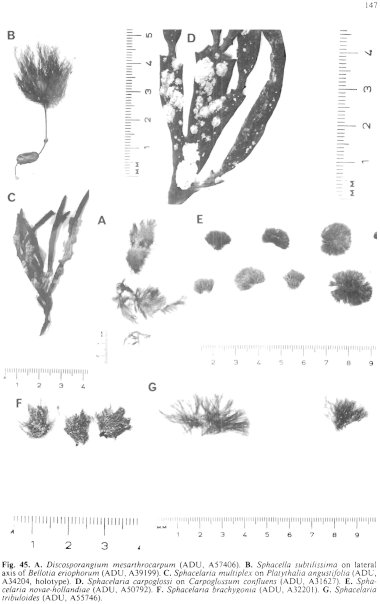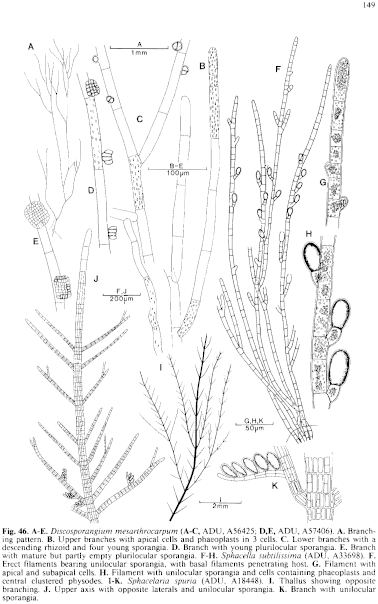|
|
|
|
|
|||||||||||
|
Electronic Flora of South Australia Species Fact Sheet
Phylum Phaeophyta – Order Sphacelariales – Family Choristocarpaceae
Selected citations: Fritsch 1945: 297, fig. 107A–F. Kjellman 1891: 191, fig. 134D–G. Kuckuck 1929: 12, fig. 4.
Thallus (Fig. 45A) greenish-brown, 3–15 (–40) mm long, tufted and fastigiate, slightly to moderately branched (Fig. 46A) irregularly laterally and usually several cells apart, with branches originating just below the cross wall, attached by descending, slightly undulate and tapering, rhizoids; epiphytic or on tyre reefs. Growth (Fig. 46B) apical, with the apical cell of similar size to lower cells, L/B 3–5 (–8). Filaments (Fig. 46B,C) slender, (14–) 16–25 µm in diameter, not tapering, uniseriate; cells thin walled, without longitudinal walls, with numerous discrete and usually distinctly separated, round to usually elongate, phaeoplasts (Fig. 46B,C), without pyrenoids; physodes apparently absent.
Reproduction: Reproduction by lateral, sessile, plurilocular, reproductive organs, forming square to slightly oblong (with rounded corner cells) plates or discs (Fig. 46D,E) on lower cells of the thallus, 40–50 µm and usually 8 locules long, 30–45 µm and usually 6 locules wide, and 15–18 µm thick, arising as lateral cells which subdivide at right angles to the parent filament (Fig. 46C,D).
Type from Dalmatia (Adriatic Sea), Mediterranean; in FI?
Distribution: Adriatic and Gulf of Naples, Mediterranean.
In southern Australia, known from the artificial tyre reefs, off Grange, S. Aust., 20 m deep on Micropeuce (Branden, 7.iii.1985; ADU, A56425) and off Glenelg, S. Aust., 18 m deep, on tyres and epiphytic (Reimers, 17.vi.1986; ADU, A57123 and 10.iii.1987; ADU, A57406) and (Branden, 20.v.1987; ADU, A57486-"Marine algae of southern Australia" No. 294).
Taxonomic notes: These collections agree well with D. mesarthrocarpum, and ADU, A57406 has abundant, mature (though empty), plurilocular organs. The earliest collection was first recognised as a member of this family by Professor C. van den Hoek of the Netherlands.
References:
FRITSCH, F.E. (1945). The structure and reproduction of the Algae. Vol. II. (Univ. Press: Cambridge.)
HAUCK, F. (1885). Die Meeresalgen Deutschlands and Oesterreichs. In Rabenhorst, L., Kryptogamen-Flora, 2nd Edn, Vol. 2. (Leipzig.)
KJELLMAN, F.R. (1891). Choristocarpaceae. In Engler, A. & Prantl, K. (Eds). Die nattirlichen Pflanzenfamilien, 1 T., 2 Abt., 190–191.
KUCKUCK, P. (1929). Fragmente einer Monographie des Pheosporeen. Biol. Anst. Helgol. 17, 1–93.
The Marine Benthic Flora of Southern Australia Part II complete list of references.
Publication:
Womersley, H.B.S. (14 December, 1987)
The Marine Benthic Flora of Southern Australia
Part II
©Board of the Botanic Gardens and State Herbarium, Government of South Australia
Illustrations in Womersley Part II, 1997: FIGS 45A, 46 A–E.

Figure 45 enlarge
Fig. 45. A. Discosporangium mesarthrocarpum (ADU, A57406). B. Sphacella subtilissima on lateral axis of Bellotia eriophorum (ADU, A39199). C. Sphacelaria multiplex on Platythalia angustifolia (ADU, A34204, holotype). D. Sphacelaria carpoglossi on Carpoglossum confluens (ADU, A31627). E. Sphacelaria novae-hollandiae (ADU, A50792). F. Sphacelaria brachygonia (ADU, A32201). G. Sphacelaria tribuloides (ADU, A55746).

Figure 46 enlarge
Fig. 46. A–E. Discosporangium mesarthrocarpum (A–C, ADU, A56425; D,E, ADU, A57406). A. Branching pattern. B. Upper branches with apical cells and phaeoplasts in 3 cells. C. Lower branches with a descending rhizoid and four young sporangia. D. Branch with young plurilocular sporangia. E. Branch with mature but partly empty plurilocular sporangia. F–H. Sphacella subtilissima (ADU, A33698). F. Erect filaments bearing unilocular sporangia, with basal filaments penetrating host. G. Filament with apical and subapical cells. H. Filament with unilocular sporangia and cells containing phaeoplasts and central clustered physodes. I–K. Sphacelaria spuria (ADU, A18448). I. Thallus showing opposite branching. J. Upper axis with opposite laterals and unilocular sporangia. K. Branch with unilocular sporangia.

|
Email Contact: State Herbarium of South Australia |

|